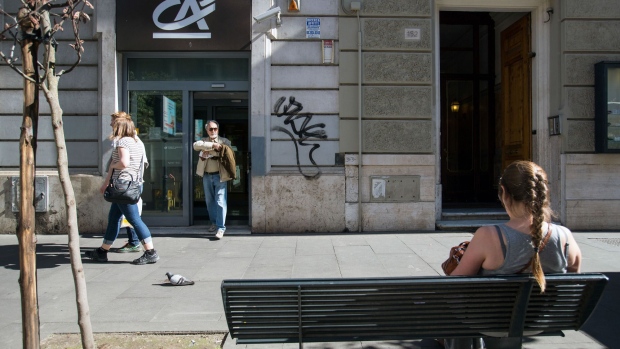Aug 6, 2020
Credit Agricole Sees Provisions Rise as Covid Hits Big Clients
, Bloomberg News

(Bloomberg) -- Credit Agricole SA set aside more than expected to cover souring loans in the second quarter after the covid pandemic hit the French lender’s retail clients and large corporate customers.
Provisions in the three months through June jumped to 842 million euros ($998 million), compared with the 775 million-euro estimate of analysts polled by Bloomberg. Costs to cover souring debt drove down results at some of the lender’s most important business units, including the large clients segment which saw a five-fold increase in the cost of risk from a year earlier.
Credit Agricole is more diversified and less dependent than rivals BNP Paribas SA and Societe Generale SA on trading, though it did benefit from the volatility that boosted fixed income results at rivals. At the same time it was able to avoid the dividend-related losses that caused management upheaval earlier this week at SocGen and Natixis.
The increase in provisions helped negate some of the benefits the bank saw in the quarter from “buoyant” business conditions. Revenue at 4.89 billion euros was in line with estimates, while net income at 954 million euros was better than expected.
The lender’s capital markets and investment banking division saw revenue climb 38% to 780 million euros, boosted by a 44% increase at the fixed income business. That was higher than SocGen’s growth but well short of the 154% debt trading surge at BNP Paribas SA.
“Our group emerges unharmed from a disruptive quarter,” Chief Executive Officer Philippe Brassac said in the statement. “As France’s leading bank, we have massively supported our customers.”
The shares closed little changed in Paris trading on Wednesday and have declined about 34% this year, better than Natixis and SocGen, though lagging BNP.
The bank said in the first quarter that it had allowed a surge in the use of credit lines at the end of March as large clients rushed to secure their financing needs when the extent of the crisis became apparent.
Other first earnings highlights:
- Revenue of 4.9 billion euros, in line with estimates
- Net income of 954 million euros vs estimates of 720 million euros
- Bank added 145,000 small business and retail customers in France
Brassac has been betting on corporate banking and asset management to offset the impact of low or negative interest rates, a weak consumer market and rising capital requirements. The bank in December wrote down the value of its French retail banking division LCL by about 600 million euros.
Credit Agricole’s giant asset manager, Amundi SA, saw total outflows of 800 million euros in the second quarter, driven by withdrawals from treasury funds that companies use to park excess cash. The business has grown into Europe’s largest with the help of acquisitions, making it a model for rivals seeking to consolidate.
Brassac has reorganized Credit Agricole’s structure and sold less-strategic holdings over the past years while seeking partnerships with other companies. The CEO in June pledged to boost net income by more than 600 million euros over three years and drive down costs, after meeting previous key targets ahead of schedule. The lender affirmed those targets in December, when it announced the goodwill charge at LCL.
©2020 Bloomberg L.P.